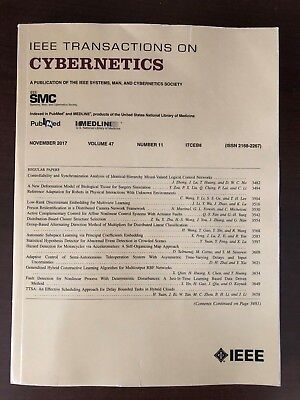层签名有向图下异构多智能体系统的二部聚类一致性层次包容控制
IF 9.4
1区 计算机科学
Q1 AUTOMATION & CONTROL SYSTEMS
引用次数: 0
摘要
本文章由计算机程序翻译,如有差异,请以英文原文为准。
Hierarchical Containment Control With Bipartite Cluster Consensus for Heterogeneous Multiagent Systems Under Layer-Signed Digraph
This article considers the hierarchical containment control (HCC) for flexible mirrored collaboration, which accommodates the bipartite cluster consensus behavior in two symmetric convex hulls formed by multiple leaders. First, to achieve the mirrored collaboration in symmetric convex hulls, the layer-signed digraph is generated by involving the antagonistic interaction. Benefiting from the hierarchical structure, the antagonistic interaction in the assistant-layer replaces the assumption of in-degree balance for the existing cluster consensus issues. Second, the existing types of control protocols and the framework of cooperative output regulation limit the achievement of the studied hierarchical mirrored collaboration. To solve this problem, the hierarchical cooperative output regulation is extended based on the formulated hierarchical mirrored collaborative errors. Third, the layer-signal compensator is designed estimating the states of leaders as well as guaranteeing the convergence of collaborative behaviors. Combining with the designed layer-signal compensator, a novel HCC protocol is proposed so that the bipartite cluster consensus behavior can be achieved simultaneously in two symmetric convex hulls. Finally, theoretical results are verified by performing the numerical simulation.
求助全文
通过发布文献求助,成功后即可免费获取论文全文。
去求助
来源期刊

IEEE Transactions on Cybernetics
COMPUTER SCIENCE, ARTIFICIAL INTELLIGENCE-COMPUTER SCIENCE, CYBERNETICS
CiteScore
25.40
自引率
11.00%
发文量
1869
期刊介绍:
The scope of the IEEE Transactions on Cybernetics includes computational approaches to the field of cybernetics. Specifically, the transactions welcomes papers on communication and control across machines or machine, human, and organizations. The scope includes such areas as computational intelligence, computer vision, neural networks, genetic algorithms, machine learning, fuzzy systems, cognitive systems, decision making, and robotics, to the extent that they contribute to the theme of cybernetics or demonstrate an application of cybernetics principles.
 求助内容:
求助内容: 应助结果提醒方式:
应助结果提醒方式:


